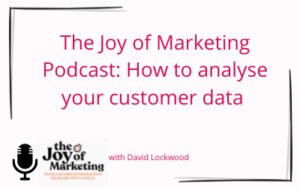In the words of nineteenth-century retailer John Wanamaker: “Half the money I spend on advertising is wasted; the trouble is I don’t know which half.” Today, measuring the impact of marketing campaigns is just as important as it ever has been.
In a recent Retail Leaders Forum, David Lockwood joined leading multi-channel DTC retailers for a lively debate on how best to measure campaign effectiveness. So let’s dive in and take a look at the highlights.
The incremental cost of recruitment
Measuring marketing at the campaign level is trickier than at the customer level because it can be measured in many different ways. Ultimately, though, a business wants to determine the incremental improvement delivered, either by the total campaign or by a particular channel, such as paid search.
While the average incremental cost of recruitment can be useful, it ignores important variations across the range of recruited customers. For example, paid search typically includes brand searches, which are usually very cheap, as well as long-tail generic searches, which are often very expensive. So, at each end of this spectrum, the cost per recruit could vary from the average by 100% or more. Therefore, marketers should break down the incremental cost of recruitment by segment to understand it fully.
Marketing cost per recruit
Marketing cost per recruit is the marketing cost of the campaign divided by the revenue it generates. However, many brands only consider media costs in this calculation. To gain an accurate measure of marketing efficiency, the cost must include promotions, since both media and promotions may be needed to recruit a customer. By including both, companies find they’re naturally spending a lot more on marketing, since promotional costs can be almost as large as media spend, or sometimes even larger.
It’s important to separate discounts into promotions and markdowns: the marketing team should be responsible for promotions, but the product team (merchandisers or buyers) should be responsible for markdowns which are due to factors such as overstocking.
The intricacies of web metrics
A lot of attention paid to web metrics, such as volumes of traffic and conversion rates. But it’s important to understand the challenges of these measures, and consider them within the context of wider marketing activities.
For example, it’s important to be wary of average figures. A campaign may be driving 30% more traffic to a company’s website, but this could be either good or bad depending on the sources of visitors. If the sources have low conversion rates, then the extra traffic could be worthless. Conversely, high conversion rates don’t necessarily indicate value, since the source could be coming from a single email containing a large promotion, sent to existing customers. In this case, the conversion rate would be higher anyway, and the value provided would still be low.
Don’t forget to measure conversion rates in relation to website changes, since rigorous UX testing and basket testing are useful for optimisation. These should be performed regularly to get the best results.
Comparative measurements
Campaign metrics provide a lot of useful information, but the question is: against what are you measuring them? Usually this is a budget (or a re-forecast if the campaign isn’t going to plan). However, the budget must be built in a way which makes the campaign’s effects easy to measure. This is best achieved by working backwards from projected results. It’s vital to include the expected number of new customers, the proportion of retained customers, and the predicted cost of both.
It’s more difficult to compare campaigns to previous activities due to the effects of COVID. March 2022 will likely be the first in three years without widespread restrictions, so the marketing environment is difficult to predict. However, preliminary data shows consumer responses heading towards a state more similar to 2019 (than 2020 or 2021).
Despite the effects of COVID, it’s still important to measure campaign results against historical data – comparison against a budget alone can produce an incomplete picture. If the budget was set without proper consideration, it’s possible to surpass it but under-achieve in other important metrics. For example, a retailer may have quadrupled the size of their customer database since 2019, and then set a budget to grow by 20%. While they could over-achieve on this basis, their customer engagement, order rate, and lapse rate may decline when compared with 2019, and go undetected. Therefore, use budget as one metric, but remember to include others to fully understand success.
DTC marketers need to work hard to fill in any knowledge gaps when measuring marketing campaigns. But if they can implement marketing metrics in the necessary context, they’ll build an accurate and powerful model of campaign activities. And this will allow business leaders to gain an intimate and intuitive understanding of performance and ROI going forward. For more advice on marketing metrics, get in touch with the team at [email protected].




